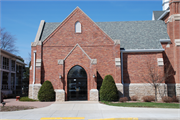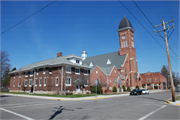Property Record
820 4TH AVE
Architecture and History Inventory
| Historic Name: | St. Peter's Roman Catholic Church |
|---|---|
| Other Name: | St. Peter's Roman Catholic Church |
| Contributing: | Yes |
| Reference Number: | 149721 |
| Location (Address): | 820 4TH AVE |
|---|---|
| County: | Portage |
| City: | Stevens Point |
| Township/Village: | |
| Unincorporated Community: | |
| Town: | |
| Range: | |
| Direction: | |
| Section: | |
| Quarter Section: | |
| Quarter/Quarter Section: |
| Year Built: | 1897 |
|---|---|
| Additions: | 1915 |
| Survey Date: | 2011 |
| Historic Use: | house of worship |
| Architectural Style: | Early Gothic Revival |
| Structural System: | |
| Wall Material: | Brick |
| Architect: | BERNARD KOLPACKI (MILWAUKEE) |
| Other Buildings On Site: | |
| Demolished?: | No |
| Demolished Date: |
| National/State Register Listing Name: | Not listed |
|---|---|
| National Register Listing Date: | |
| State Register Listing Date: |
| Additional Information: | A 'site file' exists for this property. It contains additional information such as correspondence, newspaper clippings, or historical information. It is a public record and may be viewed in person at the Wisconsin Historical Society, State Historic Preservation Office. A portion of the steeple was removed in 1951. Designated as a local landmark in 1988. Polish immigrants to the United States are best known as urban settlers, but St. Peter’s Church in Stevens Point reminds us that Poles also sought out rural areas. Wisconsin’s first distinctly Polish settlement--Poland Corner or Polonia, founded in the 1850s--lay about six miles east of Stevens Point. Settlers came from German-ruled parts of western Poland, drawn primarily by the prospect of independent landownership. Though other rural Polish enclaves sprang up later, most notably in Trempealeau County and in the farm areas northwest of Green Bay, they never reached the size of the enclave in Portage and Marathon counties--about 15,000 Poles by 1905. Not all Poles in the area were farm dwellers; fully one-third clustered in Stevens Point, where St. Peter’s Church became the focus of ethnic religious and social life. When Poles first arrived in Portage County, they attended German Catholic churches. But the Germans required them to sit in segregated areas, and the growing Polish community wanted its own priests who could preach to them in their own language. In 1876, St. Peter’s parish was founded to serve fifty Polish families. After fire destroyed the original church, the parish built a new one of brick, designed by Bernard Kolpacki of Milwaukee. St. Peter’s handsome exterior incorporates Gothic Revival lancet windows and soaring lines, and yet the design is not academic. The broad main elevation and the heavy eavesline corbeling compress the composition. Notice, too, the faceted domes. The most striking feature is a four-stage steeple, which ascends through the center of the front gable end. An entry gable leads the eye upward to a trio of tall, narrow lancets, then to three shorter lancets surmounted by a clock. On the domed fourth stage, a pinnacled gablet once pierced each face of the dome, and a concave conical finial crowned the tower. The stepped buttresses at each corner of the main facade have changed, too. They originally reached farther skyward, ending in slender conical pinnacles. Domed cupolas survive at the rear of the church, emerging from the sloping sides of the roof, but they have lost their finials. Like the exterior, the interior has evolved over the years, although unlike many churches that removed elaborate decorations after the Second Vatican Ecumenical Council (1962-65), St. Peter’s steadfastly maintained its historic interior. The original nave was plain, with a vaulted Gothic ceiling and three Gothic arches framing three altars at the front. Subsequent alterations made the interior richly opulent. The retables behind the side altars (acquired in 1910) and the one backing the main altar (installed in 1915) shelter statues of Christ, Mary, and other holy figures beneath a profusion of crocketed pinnacles. In the main retable, a lacy Gothic arch frames the Crucifixion. Also in 1915, builder and parishioner Frank Spalenka expanded the sanctuary and sacristies, and painter Victor Prais elaborately redecorated the nave. Prais’s work was virtually erased in successive renovations, and the arched moldings embracing the side altars were removed. Still hinting at the former exuberance, however, is the foliated frieze around the walls just below the vaulting. The ceiling itself is now decorated with a star motif and with circular and diamond-shaped paintings containing Biblical scenes and liturgical symbols. |
|---|---|
| Bibliographic References: | Stevens Point Daily Journal:2/13/1897; 3/27/1897; 5/24/1897; 7/10/1897; 12/18/1897; 6/23/1976. Cornerstone. Buildings of Wisconsin manuscript. |
| Wisconsin Architecture and History Inventory, State Historic Preservation Office, Wisconsin Historical Society, Madison, Wisconsin |





